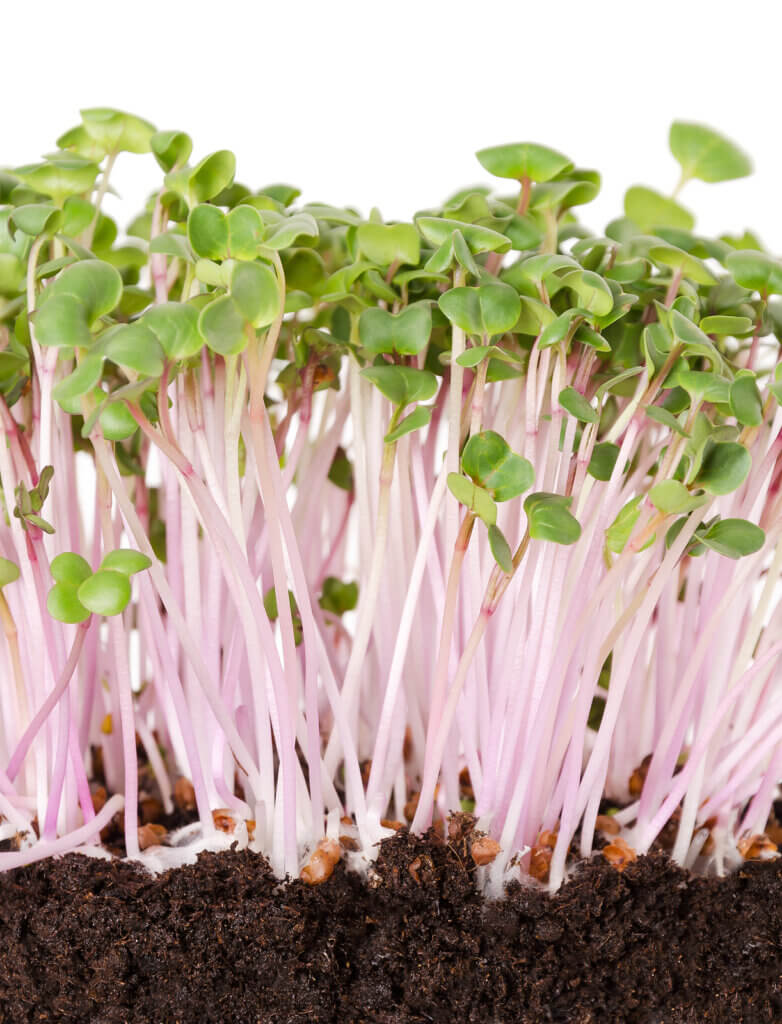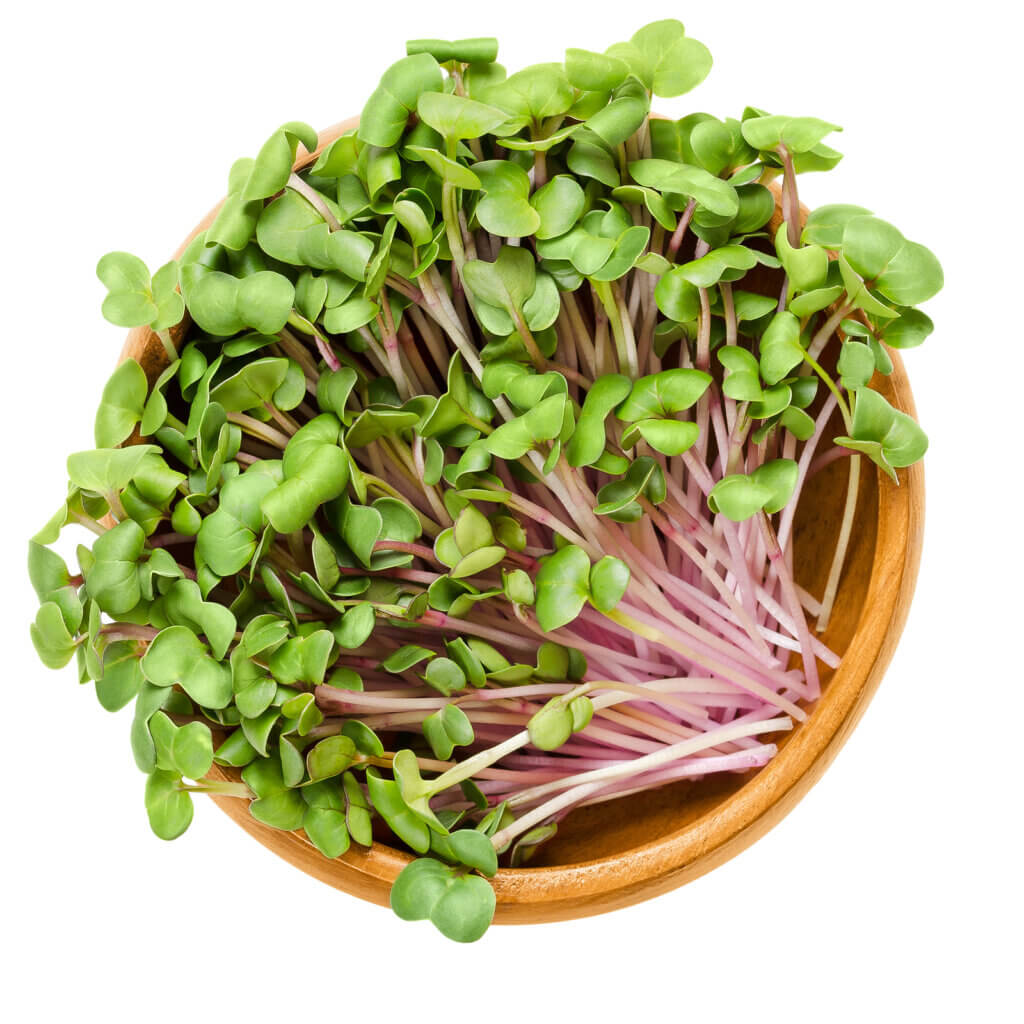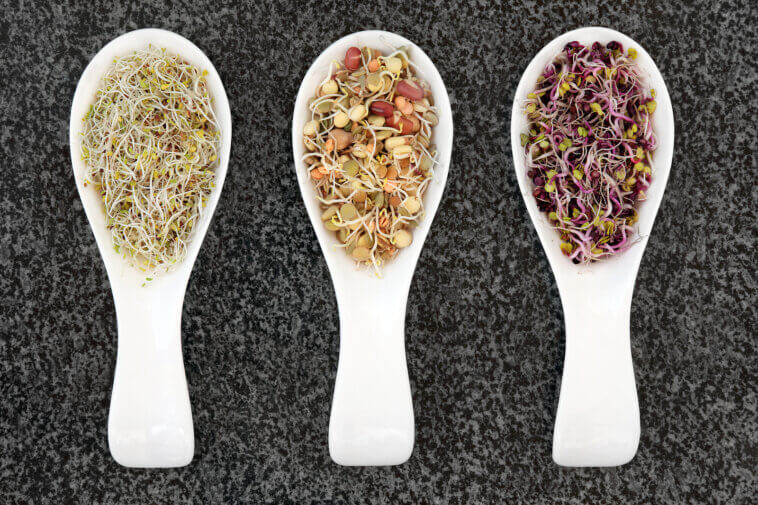Table of Contents
China Rose Radish Microgreens
China Rose Radish Microgreens have become a true favorite of mine. These tiny greens are not only bursting with vibrant flavors but also pack a serious nutritional punch.
Join me on this journey as I dive into the fascinating realm of China Rose Radish Microgreens, uncovering their incredible benefits, learning how to grow them, and exploring the exciting ways they can elevate our culinary experiences.
Whether you're a salad enthusiast, a sandwich lover, or simply looking to enhance your dishes, these microgreens are sure to become your new culinary obsession.
What Are China Rose Radish Microgreens?
China Rose Radish Microgreens, also referred to as Hong Vit Radish Microgreens, are the tender, young shoots of the Raphanus sativus plant, specifically the China Rose Radish variety.
Originating in Southeast Asia, these microgreens have a long history of cultivation dating back centuries, prized for their delightful peppery and subtly spicy taste.
In terms of their nutritional profile, China Rose Radish Microgreens stand out as a nutritional powerhouse. They are a rich source of essential vitamins, including vitamins A, C, and K, as well as important minerals like calcium, potassium, and magnesium.
Additionally, they are packed with dietary fiber, making them an excellent addition to a health-conscious diet. These microgreens also contain a significant amount of antioxidants, which play a crucial role in neutralizing harmful free radicals in the body, thereby reducing the risk of chronic diseases.
Beyond their nutritional benefits, China Rose Radish Microgreens are highly versatile in the culinary world. Their vibrant appearance and peppery flavor make them a popular choice for enhancing a wide variety of dishes.
They are frequently incorporated into salads, sandwiches, sushi rolls, and are often used as decorative garnishes for soups and main courses. Whether used as a colorful accent or to provide a zesty kick, these microgreens have the ability to elevate the flavor profile of your favorite recipes while also contributing to your overall health and well-being.

Why Grow China Rose Radish Microgreens?
- Health Benefits: Growing China Rose Radish Microgreens at home can significantly enhance your well-being. These microgreens are packed with essential nutrients, such as vitamins, minerals, and antioxidants, which can boost your immune system, aid digestion, and contribute to overall health. Moreover, their low calorie content makes them an ideal choice for those striving to maintain a healthy weight.
- Sustainability: Cultivating microgreens, particularly China Rose Radish Microgreens, aligns with sustainability efforts. These tiny plants require minimal space, water, and resources when compared to traditional vegetable farming. By growing your own microgreens, you actively reduce your environmental impact, contributing to a more eco-friendly and sustainable future.
- Market Demand: The culinary world is witnessing a surge in demand for microgreens. Restaurants and home chefs are increasingly incorporating these flavorful and visually appealing greens into their dishes. By cultivating China Rose Radish Microgreens, you can tap into this market demand and potentially supply local restaurants, farmers' markets, or consumers directly, creating an avenue for income generation.
- Flavor and Versatility: China Rose Radish Microgreens possess a unique and peppery flavor that can elevate the taste of various dishes, from salads to sandwiches and beyond. Their versatility in both savory and sweet dishes makes them a valuable addition to your culinary repertoire.
- Easy to Grow: These microgreens are relatively easy to grow, making them suitable for beginners and experienced gardeners alike. Their rapid growth cycle allows you to enjoy fresh harvests in just a few weeks, adding a sense of satisfaction to your gardening endeavors.
- Year-Round Cultivation: China Rose Radish Microgreens can be grown year-round, whether indoors or outdoors, making them a consistent source of fresh greens regardless of the season. This adaptability ensures a steady supply of nutritious and flavorful microgreens.
- Educational Experience: Cultivating these microgreens provides an excellent opportunity for educational purposes. It's a hands-on way to learn about plant growth, nutrition, and sustainable gardening practices, making it an engaging and informative hobby for all ages.
Growing China Rose Radish Microgreens
Seed Selection
To kickstart your China Rose Radish microgreen project, begin by selecting high-quality seeds. It's advisable to source your seeds from a reputable supplier to ensure they meet your needs. Look for untreated seeds explicitly labeled for microgreen production. You can conveniently acquire these seeds through online vendors or by visiting your local gardening supply stores.
Soil and Container
Create an ideal growing environment by choosing the right soil and container. Opt for a well-draining, sterile potting mix or, even better, a specialized microgreen growing medium. Select shallow containers or trays equipped with drainage holes to prevent waterlogged roots and promote healthy growth.
Planting Process
Begin the planting process by evenly spreading your China Rose Radish microgreen seeds across the surface of the soil or growing medium. Gently press them into the medium to ensure good seed-to-soil contact. Cover the seeds with a thin layer of soil or growing medium and lightly water them. It's important to plant densely, as China Rose Radish Microgreens thrive in close quarters and don't require much space between seeds.
Light and Temperature
Position your containers in a well-lit location with access to indirect sunlight or utilize specialized grow lights. Maintaining a consistent temperature of around 70°F (21°C) is crucial for optimal growth. Ensure that the microgreens receive adequate light for photosynthesis, which is essential for their development.
Watering and Humidity
Carefully manage the watering routine to provide the right amount of moisture. Keep the soil consistently moist, but avoid overwatering, as waterlogged soil can harm the microgreens. To maintain appropriate humidity levels, consider using a spray bottle to mist the microgreens occasionally, particularly in dry climates.
Harvesting
After approximately 10-14 days, your China Rose Radish Microgreens should be ready for harvesting. To harvest them, use scissors to cut the microgreens just above the soil level. After harvesting, be sure to rinse them thoroughly to remove any lingering soil particles, and allow them to drain before using them in your culinary creations.

Common Challenges and Solutions
Pests and Diseases
One of the common challenges faced when cultivating China Rose Radish Microgreens is dealing with pests and diseases. Two prevalent pests that can affect these microgreens are aphids and spider mites. To combat infestations, consider using organic pest control methods such as neem oil.
Another effective strategy is introducing beneficial insects like ladybugs, which can help keep the pest population in check. Additionally, maintaining proper hygiene and conducting regular inspections of your microgreen trays can be proactive measures to prevent disease outbreaks.
Leggy Growth
Another issue you might encounter is leggy growth in your China Rose Radish Microgreens. This condition occurs when the microgreens grow too tall and spindly, which can adversely affect their quality. The primary cause of leggy growth is usually insufficient light.
To address this problem, it's essential to adjust the light source or intensity. Providing adequate and consistent light will encourage compact and healthy growth in your microgreens.
Mold and Mildew
Mold and mildew can become problematic, particularly in humid growing conditions. To prevent the development of fungal growth, you should take several steps. First, improve ventilation in your growing area to reduce humidity levels. Proper airflow can help keep the environment less conducive to mold and mildew.
Secondly, avoid overwatering your microgreens, as excess moisture can promote fungal issues. Maintaining a proper watering routine and ensuring the growing medium has good drainage can go a long way in preventing mold and mildew from taking hold in your China Rose Radish Microgreens.
Culinary Inspirations
Expand your culinary horizons with these creative ideas for incorporating China Rose Radish Microgreens into your dishes:
Salad Recipes
Explore the vibrant world of salads with our China Rose Radish Microgreens. These petite greens bring a burst of flavor to your dishes.
Try the delightful China Rose Radish and Arugula Salad, which combines these microgreens with peppery arugula, juicy cherry tomatoes, creamy goat cheese, and a luscious balsamic vinaigrette dressing. It's a symphony of flavors in every bite.
For an Asian-inspired twist, infuse your coleslaw with a spicy kick by incorporating these microgreens, turning a classic into something extraordinary.
Sandwich and Wrap Ideas
Get creative with your sandwiches and wraps by introducing the zesty charm of China Rose Radish Microgreens. The Spicy Radish Wrap is a perfect blend of flavors and textures. Layer the microgreens with tender grilled chicken, creamy avocado slices, and a tantalizing spicy mayo sauce, all wrapped up in a soft tortilla.
If you prefer an open-faced option, try the Open-faced Radish Sandwich. Spread cream cheese generously on whole-grain bread, top it with smoked salmon, and finish with a generous sprinkle of our delightful microgreens for a sophisticated twist on a classic.
Garnish and Garniture
Take your culinary presentation to the next level with our China Rose Radish Microgreens. Elevate your soups by adding a small cluster of these microgreens as a beautiful garnish. The vibrant colors and peppery taste will make your soup a visual and gastronomic delight.
And don't forget to experiment with sushi rolls – roll these microgreens into your homemade sushi creations for a surprising burst of peppery freshness in every bite.
China Rose Radish Microgreens Varieties
When it comes to China Rose Radish Microgreens, there's a diverse selection that goes beyond the classic Hong Vit variety. Each variety not only boasts its unique flavor profile but also adds distinct visual elements to your dishes. Delve into the world of China Rose Radish Microgreens and consider experimenting with these exciting variations:
- Red Streaks Microgreens: If you're looking to inject a vibrant burst of color into your culinary creations, Red Streaks Microgreens are the perfect choice. These microgreens are characterized by their striking red stems and leaves, which not only add visual appeal but also offer a delightful peppery flavor.
- Green Stem Microgreens: In contrast to their red-stemmed counterparts, Green Stem Microgreens offer a milder flavor. This makes them incredibly versatile for a wide range of culinary applications. Their subtle taste can complement various dishes, allowing for creative experimentation in the kitchen.
- Daikon Radish Microgreens: For those seeking a unique and slightly spicy flavor, Daikon Radish Microgreens are a fantastic option. These microgreens are derived from the Daikon radish variety and provide a distinctive taste profile that combines a hint of spiciness with the fresh crunchiness of microgreens. Incorporating Daikon Radish Microgreens can elevate the flavor complexity of your dishes.
Tips for Storing China Rose Radish Microgreens
Proper storage ensures that your China Rose Radish Microgreens remain fresh and flavorful for longer periods. Here are some tips to follow:
Post-Harvest Drying
Following the harvest of your China Rose Radish Microgreens, it's crucial to gently pat them dry using a paper towel. This step is essential for removing any excess moisture clinging to the microgreens.
Airtight Container or Plastic Bag
To further safeguard your microgreens against moisture buildup and contamination, transfer them to an airtight container or a resealable plastic bag. Placing a paper towel inside the container or bag will absorb any lingering moisture, preventing the microgreens from becoming soggy.
Refrigeration
The optimal storage location for your microgreens is the vegetable crisper drawer in your refrigerator. This compartment offers a stable environment in terms of both temperature and humidity. Maintaining a consistent environment is essential for preserving the freshness and nutritional content of your microgreens.
Consume Promptly
For the most vibrant taste and nutritional benefits, it's advisable to consume your China Rose Radish Microgreens within one week of harvesting. Freshness and nutritional value tend to decline with time, so enjoy them while they are at their best.
Proper Harvesting Technique
Start by harvesting your microgreens at the right stage of growth. Ideally, harvest when they are about 1-2 inches tall. This ensures that they are at their peak flavor and nutritional value, making storage more effective.
Regularly Check for Moisture
Even after the initial drying and storage, periodically check your microgreens for any moisture accumulation. If you notice condensation inside the container or bag, remove it immediately to prevent mold and spoilage.
Use Ventilated Containers
While airtight containers are ideal for moisture control, consider using containers with small ventilation holes or airtight lids with adjustable vents. This can help maintain an optimal level of humidity and prevent excessive moisture buildup.
Label and Date Containers
To keep track of freshness and rotation, label your storage containers with the date of harvest. This practice will help you prioritize the consumption of older batches and maintain a consistent supply of fresh microgreens.
Avoid Crushing or Compressing
Handle your microgreens with care to prevent bruising or crushing. Delicate microgreens can lose their texture and flavor when compacted, so avoid heavy stacking or pressing down on them.
Consider Vacuum Sealing
If you're looking for an airtight storage option, consider using a vacuum sealer to remove all air from the storage bag or container. This can significantly extend the shelf life of your microgreens.
FAQs (Frequently Asked Questions)
What are China Rose Radish Microgreens?
China Rose Radish Microgreens are the young seedlings of the Raphanus sativus plant, specifically the China Rose Radish variety. These microgreens are known for their peppery and slightly spicy flavor and vibrant pinkish-red stems and leaves.
What are the nutritional benefits of China Rose Radish Microgreens?
China Rose Radish Microgreens are packed with essential nutrients, including vitamins A, C, and K, as well as minerals like calcium, potassium, and magnesium. They are also rich in dietary fiber and antioxidants, making them a healthy addition to your diet.
How can I use China Rose Radish Microgreens in my dishes?
These microgreens can be used in various culinary applications. Add them to salads, sandwiches, wraps, and sushi rolls for a peppery kick. They also make an attractive garnish for soups and entrees.
Can I grow China Rose Radish Microgreens indoors?
Yes, you can easily grow China Rose Radish Microgreens indoors. They thrive in well-lit areas with indirect sunlight or under grow lights. Indoor cultivation allows you to enjoy fresh microgreens year-round.
What are the common challenges in growing China Rose Radish Microgreens?
Common challenges include pests (like aphids and spider mites), leggy growth due to inadequate light, and the development of mold or mildew in humid conditions. Proper care and attention can help mitigate these issues.
How long does it take to grow China Rose Radish Microgreens?
China Rose Radish Microgreens typically take about 10-14 days to reach maturity after planting. The exact time may vary depending on factors like temperature and light conditions.
Where can I purchase China Rose Radish microgreen seeds?
You can buy China Rose Radish microgreen seeds from reputable online seed suppliers or local gardening stores. Ensure that the seeds are labeled specifically for microgreen production and are untreated.
Are there any specific health benefits associated with consuming China Rose Radish Microgreens?
Yes, China Rose Radish Microgreens are known for their potential health benefits. They can boost the immune system, aid in digestion, and provide a source of antioxidants that may help reduce the risk of chronic diseases.
Are there any culinary recipes that highlight the flavor of China Rose Radish Microgreens?
Absolutely! These microgreens can be used in various dishes. Try them in salads, sandwiches, wraps, or as a garnish for soups. You can find creative recipes and serving ideas in the “Culinary Inspirations” section of this guide.
Can I sell China Rose Radish Microgreens for profit?
Yes, there is a growing market demand for microgreens, including China Rose Radish Microgreens. You can consider selling them to local restaurants, farmers' markets, or directly to consumers as a potential source of income.
Conclusion
My personal journey with China Rose Radish Microgreens has evolved into a profound culinary fascination. These vibrant, flavorful microgreens have not only added a burst of freshness to my dishes but have also enriched my understanding of sustainable gardening and nutrition.
Growing them at home has not only given me a sense of accomplishment but also aligned with my commitment to reducing my environmental impact. Furthermore, their versatility in enhancing salads, sandwiches, and even soups has allowed me to express my creativity in the kitchen.
Overall, China Rose Radish Microgreens have become a source of inspiration and a gateway to a healthier, more sustainable, and more flavorful way of life, inviting others to embark on this remarkable journey of growth, flavor, and discovery.




Comments
Loading…